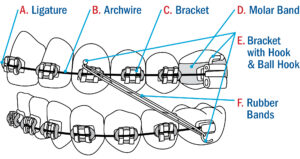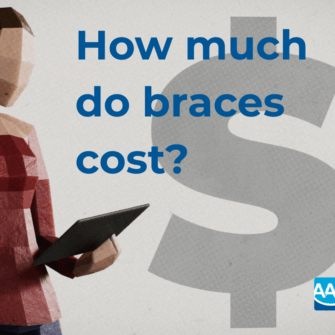Life during orthodontic treatment will include periodic visits to the orthodontist, possibly some minor changes in diet for the duration of treatment, and more frequent toothbrushing along with daily flossing.
Braces diagram
This diagram below illustrates and names the parts of a typical set of braces.

A. Ligature The archwire is held to each bracket with a ligature, which can be either a tiny rubber band or a twisted wire. B. Archwire The archwire is fastened to all of the brackets and creates force to move teeth into proper alignment. C. Brackets Brackets are bonded directly onto each tooth. The archwire is held in place by a series of brackets. D. Molar Bands A metal band with a bracket attached is wrapped around select molars for additional anchorage. E. Bracket with Hook and Ball Hook Hooks and ball hooks, each attached to a bracket, are used for the attachment of rubber bands (elastics), which help move teeth toward their final position. F. Rubber Bands Rubber bands (elastics) are used to temporarily connect brackets between the upper and lower jaw to add force for additional tooth movement.
How often will we see the orthodontist?
Visits to the orthodontist to adjust braces or to pick up new aligners, at which time your orthodontist will evaluate the progress of treatment and assess the health of the teeth and gums, will be scheduled about every 6 to 10 weeks.
How long will treatment last?
The length of treatment is different for each patient because each patient has a unique problem. Your AAO orthodontist will give you an estimated length of treatment. Here are five tips to make your treatment go as quickly as possible:
- Follow your orthodontist’s instructions on the frequency of brushing and flossing, and see your dentist for a professional cleaning at least every six months during orthodontic treatment, or more often if recommended.
- Watch what you eat if you have braces. Certain food textures, such as crunchy and sticky, can damage braces. Please consult a nutritionist about food choices if you are struggling with an eating disorder/disordered eating. If unsure, soft and easy to chew foods are go-to options. If you have aligners, be sure to remove them before you eat or drink anything besides tap water, and put them back in after you’re done eating or drinking and you have thoroughly cleaned your teeth.
- Sugary, acidic soft drinks including regular and diet soda pop, fruit juices, fruit drinks and sports drinks can damage braces/aligners. Tap water is recommended.
- If prescribed, wear your elastics (rubber bands) as instructed.
- Keep scheduled appointments with your orthodontist.
What do I do if a bracket or wire comes loose, or if I misplace an aligner?
If a bracket or wire comes loose, or if you lose or break an aligner, let your orthodontist know right away. Broken braces cannot deliver the right forces to move your teeth, and that could prolong treatment. Aligners should be worn in a particular sequence. Your orthodontist is the best person to call for advice about next steps, and to advise whether a lost aligner will extend your treatment time.
We have a special event coming up – can braces be removed?
Discuss this with your orthodontist. But be aware that premature removal of braces may not be in your best interests for a stable, functional result from orthodontic treatment.
We won’t need to see the dentist during orthodontic treatment, right?
It’s critical that you continue seeing your family dentist during orthodontic treatment. Your dentist will provide professional cleanings and check-ups, and like your orthodontist, will keep an eye on oral health. Visit your dentist at least every six months during orthodontic treatment, or more often, if recommended.
Do braces cause discomfort?
There can be some initial discomfort when braces are placed, or for a short time after braces are adjusted, but this is temporary. Overall, orthodontic discomfort is short-lived and easily managed. Once patients become accustomed to their braces, they may even forget they have them on.
How much work/school will we miss?
There may be some time away from work or school during your orthodontic treatment, but your orthodontist will do his/her best to minimize it. If you have braces, the longest appointments will be to place and remove your braces, and will likely be scheduled during the work day. Appointments to adjust braces or pick up a new set of aligners, scheduled every 6 to 10 weeks, are usually short.
How often should you brush?
Your orthodontist will give specific instructions, but in general, you should brush for two minutes after every meal or snack, and before bed. Carry a travel toothbrush and small tube of toothpaste with you so you can brush when you’re away from home. Bring along floss and an interproximal brush, too. If you’re in a pinch and absolutely are not in a position to brush after eating or drinking at the very least rinse with plain water. It can help you get rid of some food particles or traces of beverages
What kind of toothpaste should you use?
Fluoride toothpaste is recommended, approved by the American Dental Association, preferably without any whitening.
How often should you floss?
A minimum of once a day.
I don’t like to floss.
Flossing is crucial to successful orthodontic treatment, and to on-going oral health. Flossing removes plaque from parts of your teeth that brushing alone can’t reach. Plaque is the enemy – it’s the source of disease processes in teeth and gums.
Why is all this brushing and flossing necessary?
Brushing and flossing keep teeth and gums clean by removing plaque and food debris. When plaque and trapped food are left on the teeth and around braces, the outcome can be cavities, swollen gums, bad breath and permanent white marks on the teeth. Maintaining good oral hygiene helps to minimize your time in treatment, and contributes to a healthy result.
Manual toothbrush or a power toothbrush?
Use the toothbrush that works best for you. Make sure you brush for two minutes each time you brush! Change the toothbrush or power toothbrush head at the first sign of wear, or at least every three months.
Are there other tools we can use to help with oral hygiene?
Here are three handy oral hygiene tools:
- Interproximal brushes – these are great at dislodging plaque and food particles trapped between teeth, and to clear out debris that catches on brackets and wires.
- Water irrigators – these can flush out food particles in a jif!
- Fluoride mouth rinse – whether over-the-counter or prescription strength, a daily fluoride rinse can strengthen tooth enamel and help prevent white marks (decalcification).
Your orthodontist may suggest dipping an interproximal brush in a capful of fluoride rinse to deliver fluoride protection between the teeth, or using a fluoride rinse instead of water in an irrigator.
What can you eat with braces?
A healthy, diverse diet supports the body as it undergoes the biological changes that occur during orthodontic treatment. You are encouraged to enjoy a variety of healthful, easy-to-chew foods during orthodontic treatment. Soft or liquid foods like soups, stews, casseroles, pasta, scrambled eggs, and smoothies can be eaten as usual. Fresh fruits like apples and pears, should be sliced rather than bitten into. Softer foods that require biting into, such as sandwiches and pizza should be cut into bite-sized pieces before eating. Cut corn off the cob before serving.
What can’t you eat?
Foods that are hard, sticky, crunchy or chewy that cannot be modified to easily eat without getting stuck should be avoided for the duration of treatment as they may damage braces/brackets. Examples include foods such as hard pretzels, hard pizza crust, crusty bread, taco chips, caramels, popcorn, licorice, taffy, suckers, hard candies or mints and nuts.
What about drinks?
Tap water and milk are your best choices for drinks while braces are on. Beverages like coffee, tea and red wine can stain teeth. Try to avoid these, or keep them to a minimum. Avoid regular and diet soft drinks when wearing braces. These drinks include soda pop, sports drinks/energy drinks, flavored bubbly waters and fruit drinks (juices, punch). These drinks contain acids and/or sugars that dissolve tooth enamel and can lead to cavities. Be sure to brush right away after drinking a soft drink. If brushing is not possible, rinse thoroughly with water.
What can you eat with aligners?
A healthy diet supports the body as it undergoes the biological changes that occur during orthodontic treatment. You are encouraged to enjoy a variety of healthful foods during orthodontic treatment. Just be sure to take your aligners out before you eat, and before you put them back in, clean your teeth thoroughly.
What can’t you eat?
Nothing is off-limits. Just be conscious of the need to take out aligners to eat, and to clean your teeth before putting your aligners back in.
What about drinks?
Tap water is the only beverage that is safe to drink when your aligners are in. When wearing your aligners, avoid everything except tap water. You can remove your aligners to drink anything other than tap water. You’ll need to brush your teeth before putting your aligners back in. Except for tap water, remove aligners when drinking. After drinking, brush right away before putting your aligners back in.
Are there orthodontic emergencies?
Occasionally things happen to braces or aligners during orthodontic treatment. They may require a call or an unforeseen visit to the orthodontist – what your orthodontist will consider an “emergency visit.”
Will we have to see the orthodontist?
Whether you will need to be seen by the orthodontist will depend on what has happened to your appliance. Contact your orthodontist’s office to explain the problem and determine if you need to be seen.
When does the orthodontist need to know something has happened?
If you notice a bracket is loose or if a wire has worked itself out of place, or if there is unusual discomfort, notify your orthodontist.
Are there things I can do at home to treat discomfort?
Keep supplies on hand to address possible situations. Here are six suggestions:
- Orthodontic wax.
- Dental floss.
- Tweezers.
- Interproximal brushes.
- Topical anesthetic (such as Orabase or Ora-Gel).
- Over the counter pain relievers (such as one taken for a headache).
A warm salt water rinse can be soothing, as well (1 tsp. salt to 8 oz. warm water).
Can sports be played during orthodontic treatment?
Yes. But talk to your orthodontist about the type of mouth guard to wear.



